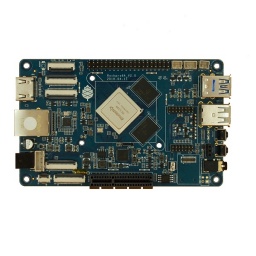NixOS on ARM/PINE64 ROCKPro64
| PINE64 ROCKPro64 | |
|---|---|

| |
| Manufacturer | PINE64 (Pine Microsystems Inc.) |
| Architecture | AArch64 |
| Bootloader | Upstream U-Boot |
| Boot options | microSD, eMMC, SPI NOR Flash |
The ROCKPro64 is a powerful single board computer built around the Rockchip RK3399 SoC.
There are two models of the board, with 2 or 4 GB of RAM. It can boot from an microSD card or an eMMC. It also has a 128 Mbit SPI flash that can be used to store the bootloader.
Status
This board has upstream U-Boot and kernel support, although the mainline kernel may still be missing some features. NixOS can be installed using manual partitioning and nixos-install or by modifying the aarch64 installation image as described in the next section.
U-Boot for this board is packaged in nixpkgs, and Hydra builds can be found here: https://hydra.nixos.org/job/nixpkgs/trunk/ubootRockPro64.aarch64-linux
It can also be cross compiled with
nix-build '<nixpkgs>' --argstr system aarch64-linux -A ubootRockPro64 --out-link ubootRockPro64
Board-specific installation notes
You can use nixos-aarch64-images to get an rockpro64 compatible disk image or running the commands manually as described below:
U-Boot needs to be copied to specific sectors on the microSD card, eMMC or image with dd. Download/build U-Boot for the board, and write idbloader.img and u-boot.itb to the correct locations with (replace /dev/mmcblkX with the correct path to the card or image):
dd if=idbloader.img of=/dev/mmcblkX conv=fsync,notrunc bs=512 seek=64
dd if=u-boot.itb of=/dev/mmcblkX conv=fsync,notrunc bs=512 seek=16384
On many kernels, the ethernet driver cannot handle hardware check-summing of large packets, therefore this feature must be disabled for the ethernet to be stable. This can be done with the following NixOS configuration:
networking.localCommands = ''
${pkgs.ethtool}/bin/ethtool -K eth0 rx off tx off
'';
Alternative installation
Use U-Boot or Tow-Boot to enable UEFI booting.
First, download or compile the bootloader. Then flash the SPI version on EMMC, boot from it, and use keyboard to confirm SPI flashing. If there's no HDMI output, use serial console with 115200 baud rate. From now on, board will boot from SPI.
Then make a USB drive with NixOS minimal ISO image for 64-bit ARM, and choose USB while booting. Proceed with the regular NixOS setup flow, with GPT/MBR partitioning, and without putting bootloader in the beginning of the EMMC.
Serial console
The ROCKPro64 uses a GPIO pinout compatible with the Raspberry Pi 2 and newer. This means that the following pins can be used to connect a serial adapter:
| Pi-2 Bus | |
|---|---|
| Pin | Function |
| 6 | GND |
| 8 | UART0_TX |
| 10 | UART0_RX |
See https://wiki.pine64.org/wiki/ROCKPro64#GPIO_Pins for list of all pins
The serial console runs at 1500000 baud in the bootloader.
To connect check your dmesg for an identifier of the serial console:
[78635.965459] usb 2-1: new full-speed USB device number 8 using xhci_hcd
[78636.119008] usb 2-1: New USB device found, idVendor=1a86, idProduct=7523, bcdDevice= 2.63
[78636.119017] usb 2-1: New USB device strings: Mfr=0, Product=2, SerialNumber=0
[78636.119022] usb 2-1: Product: USB2.0-Serial
[78636.127103] ch341 2-1:1.0: ch341-uart converter detected
[78636.142043] usb 2-1: ch341-uart converter now attached to ttyUSB0In our example that coresponds to the ttyUSB0 which makes a new device available at /dev/ttyUSB0 to which you can connect using for (example) picocom:
# Connect to /dev/ttyUSB0 at baud 1500000
$ nix-shell -p picocom --run "picocom /dev/ttyUSB0 -b 1500000"
See https://wiki.pine64.org/wiki/ROCKPro64#Setup_a_Serial_Console_.28UART.29 for more information on setting up the serial console